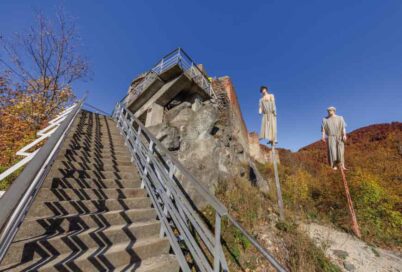- You have no items in your shopping cart
- Subtotal: 0.00€
Bran Castle
Surrounded by an aura of mystery and legend and perched atop a 200ft high rock, Bran Castle owes its fame to its imposing towers and turrets as well as the myth created around Bram Stocker’s Dracula.
Bran Castle is located in the Brasov region, on the DJ73 road between Râsnov and Rucar, at the foot of Bucegi National Park.
This castle is easily accessible by road by car, and is probably the most visited tourist site in Romania.
So plan your visit accordingly, and expect the crowds, especially during the holiday and summer periods.
Admission costs 35 lei / person and includes photo fees (non-contractual information).
The first known fortress near Bran Pass (now called Rucăr-Bran Pass), a trade route through the Carpathian Mountains, was erected after 1211 by knights of the Teutonic Order but held only briefly. In 1377, King Ludwig I allowed the Transylvanian Saxons from the Brașov region to build a castle as a bulwark against the northward expansion of the Ottoman Empire. The castle was completed in 1388; it also served as a customs post for Transylvania. In the early 15th century, King Sigismund temporarily ceded possession of the castle to Prince Mircea the Elder of Wallachia, a neighboring territory threatened by the Ottoman Turks. In 1441, János Hunyadi, voivode (governor) of Transylvania, defeated an Ottoman army at the castle.
In 1459, Vlad Tepes, named “Dracula”, arrived in Bran, being in fact the voivode of Wallachia at that time. He kills 100 Saxons there for a conflict of interest and will acquire a bad reputation.
The castle suffered significant damage throughout its life. The powder reserve wicked away in 1593, a storm ravaged the roof in 1617. Fortunately, it was under the reign of Gabriel Bethlen (1613-1629) that it was rebuilt and refurbished
It loses its military and border role in 1836 and will be abandoned from 1888 to 1918, becoming useless.
In 1919, after the First World War, Ferdinand I brought together Transylvania, Wallachia and Moldavia in the same country, Romania.
His wife, Queen Marie of Romania, will be offered Bran Castle by the people. She likes it very much and she will make restorations and improvements to make it more “royal”. It becomes his summer residence.
Queen Mary died in 1938 and her daughter, Princess Ileana, would inherit Bran Castle. During the Second World War, she built a hospital and cared for the war wounded until 1948. Unfortunately, she had to flee the country when the communist regime arrived. In 1956, the castle became a museum bringing together royal heritage, medieval heritage and an ethnographic museum.
The last renovations were completed from 1987 to 1993 and in 2006 the castle belonged by right to the 3 heirs of Princess Ileana.
Bran Castle is often associated with the fictional vampire Count Dracula. Romanian Castle resembles Dracula’s Castle, as depicted in Bram Stoker’s novel Dracula (1897), in that both stand on rocky precipices and offer spectacular views. But Stoker, an Irish writer, is not known to have ever visited Transylvania. Vlad, grandson of Mircea the Elder, was a voivode of Wallachia in the 15th century.
Want to see more fortresses in Romania? Discover the Rasnov fortress by clicking here.
More images of the castle by clicking here.













